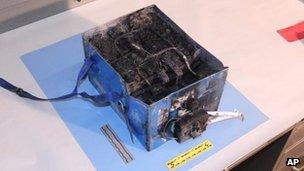Dreamliner: No fault found with Boeing 787 battery
- Published

Airline safety inspectors have found no faults with the battery used on Boeing's 787 Dreamliner, Japan's transport ministry has said.
The battery was initially considered the likely source of problems on 787s owned by two Japanese airlines.
It has raised fears that there will be no quick fix to a problem that meant all 50 787s in service were grounded.
Attention has now shifted to the electrical system that monitors battery voltage, charging and temperature.
Transport ministry official Shigeru Takano said "we have found no major quality or technical problem" with the lithium-ion batteries. Shares in GS Yuasa, which makes the batteries, jumped 5% on the news.
"We are looking into affiliated parts makers," he said. "We are looking into possibilities."
The safety investigation started after one of the 787s operated by All Nippon Airways made an emergency landing in Japan when its main battery overheated. Earlier, a battery in a Japan Airlines 787 caught fire while parked at Boston's Logan International Airport.
Zafar Khan, aviation analyst at Societe Generale, said: "The obvious implication is that it may prolong the grounding.
"If it's not the battery then we are back to the drawing board. We know it's an electrical - and not a structural - issue and that will be the focus for the inspectors. But there's a lot of cabling on these aircraft."
'Fingers crossed'
Keith Hayward, head of research at the Royal Aeronautical Society, said that if the issue is no longer about replacing a faulty battery, it raised the prospect of Boeing having to do a major re-design.
"I think people had their fingers crossed that it was a battery fault... it looks more systemic and serious to me. I suspect it could be difficult to identify the cause," he said.
He added that aviation regulators will have to put the 787 through another airworthiness certification process, which itself could become a complicated and lengthy process depending on the final cause of the problem.
Two weeks ago the US Federal Aviation Administration said both batteries had leaked electrolyte fluid, and there had been smoke damage to parts of the aircraft.
The FAA said airlines must demonstrate battery safety before flights could resume, a statement that effectively meant airlines had to ground their 787s.
Boeing, which competes against Europe's Airbus, has halted 787 deliveries. Boeing has orders for more than 800 Dreamliners.
The 787 is the first airliner made mostly from lightweight composite materials, which increases an aircrafts fuel efficiency. It also relies on electronic systems rather than hydraulic or mechanical systems to a greater degree than any other airliner.
Compensation
Mr Khan said that most analysts had forecast that the 787 would be out of service for, perhaps, eight weeks at most. Beyond 10-12 weeks, and it could impact on Boeing's production line and future deliveries, he said.
"That raises questions of damages (to airlines) for late delivery and the leasing of alternative aircraft," he said.
Last week, analysts at Bernstein put the cost of fixing the Dreamliner at about $350m (£222m). Meanwhile, Jefferies estimated the likely cost at between $250m to $625m. But that was before the likely primary cause - the battery - was ruled out.
Depending on the cause of the problem, Boeing might be able to recoup any costs from suppliers. But analysts say that the longer the issue continues, the higher the risk for Boeing, suppliers, jobs, and investors.
On Wall Street, Boeing shares opened almost 1% down and are more than 4% lower since the issue came to light. "The amazing thing is that the share price has held up so well," said Mr Khan.
- Published17 January 2013
- Published13 March 2013
- Published17 January 2013
- Published21 January 2013
- Published18 January 2013
- Published17 January 2013
- Published17 January 2013